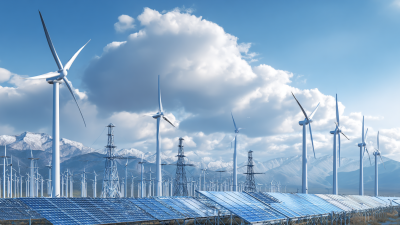Revolutionizing Energy Solutions: Innovative Approaches for a Sustainable Future
In the quest for a sustainable future, innovative approaches to energy solutions are becoming increasingly critical. As we face the pressing challenges of climate change and resource depletion, traditional energy systems must be rethought and transformed.
 This article explores revolutionary energy solutions that not only address current environmental concerns but also pave the way for a greener and more resilient planet. By examining cutting-edge technologies, community-driven initiatives, and policy reforms, we aim to demonstrate how diverse strategies can converge to create effective energy solutions. We will delve into various facets of renewable energy, energy efficiency, and smart infrastructure, highlighting the essential role that innovation plays in shaping a sustainable energy landscape.
Join us as we uncover the transformative potential of these energy solutions and their capacity to empower individuals, communities, and nations toward a more sustainable future.
This article explores revolutionary energy solutions that not only address current environmental concerns but also pave the way for a greener and more resilient planet. By examining cutting-edge technologies, community-driven initiatives, and policy reforms, we aim to demonstrate how diverse strategies can converge to create effective energy solutions. We will delve into various facets of renewable energy, energy efficiency, and smart infrastructure, highlighting the essential role that innovation plays in shaping a sustainable energy landscape.
Join us as we uncover the transformative potential of these energy solutions and their capacity to empower individuals, communities, and nations toward a more sustainable future.
Innovative Renewable Energy Technologies Leading the Change
In recent years, innovative renewable energy technologies have emerged as pivotal players in the quest for a sustainable future. Among these, solar energy advancements have transformed traditional photovoltaic systems into more efficient and affordable solutions. The development of bifacial solar panels, which capture sunlight from both sides, has significantly increased energy output while reducing installation costs. Similarly, floating solar farms are gaining traction, allowing for energy generation on bodies of water, thereby saving land space and reducing water evaporation.
Wind energy is also experiencing revolutionary changes, with new turbine designs that maximize efficiency in various wind conditions. Vertical-axis wind turbines, for instance, have been designed for urban environments, making wind energy more accessible and versatile. Furthermore, offshore wind farms continue to expand, tapping into powerful ocean winds to meet growing energy demands. Overall, these innovations not only provide cleaner energy sources but also contribute to the reduction of carbon footprints, setting the stage for a sustainable energy landscape.
The Role of Energy Storage in Efficient Resource Management
 Energy storage systems (ESS) are pivotal in optimizing resource management, particularly in the context of rising global energy demands and the integration of renewable energy sources (RES). Recent studies highlight that combining ultra-fast direct current (DC) charging with ESS can significantly enhance the operational efficiency of electric vehicle (EV) charging stations. This integration not only aligns with user preferences but also effectively balances grid demands, essential for smart energy systems striving for sustainability.
Energy storage systems (ESS) are pivotal in optimizing resource management, particularly in the context of rising global energy demands and the integration of renewable energy sources (RES). Recent studies highlight that combining ultra-fast direct current (DC) charging with ESS can significantly enhance the operational efficiency of electric vehicle (EV) charging stations. This integration not only aligns with user preferences but also effectively balances grid demands, essential for smart energy systems striving for sustainability.
Tip: To maximize the benefits of energy storage, consider implementing a real-time adaptive resource allocation strategy. By leveraging IoT and deep learning technologies, energy managers can optimize grid performance dynamically, responding to fluctuations in demand while utilizing renewable energy efficiently.
Moreover, advancements in lithium-ion battery technology continue to drive the potential of energy storage. Recent reviews emphasize improvements in electrode materials and electrolytes, which are crucial for enhancing the lifespan and capacity of these batteries. With a projected market size of over USD 4084.6 million by 2034, energy storage systems are becoming increasingly central to achieving a sustainable energy landscape.
Tip: Collaborating with specialized firms dedicated to energy storage can significantly improve implementation strategies, ensuring optimized storage solutions tailored to specific energy management needs while promoting sustainability.
Smart Grid Solutions: Enhancing Energy Distribution and Management
As the world shifts towards more sustainable energy solutions, smart grid technology has emerged as a pivotal player in enhancing energy distribution and management. According to the U.S. Department of Energy, the advanced deployment of smart grids could potentially save consumers up to $200 billion in energy costs over the next 20 years. By integrating digital technology with traditional power systems, smart grids facilitate real-time monitoring and management of electricity flows, which optimally balances supply and demand.
The adoption of smart grid solutions is also fostering renewable energy integration. A report by the International Energy Agency (IEA) highlights that, by 2030, renewable energy sources are expected to account for 30% of global electricity generation. Smart grids enable this transition by utilizing data analytics and automation to predict energy requirements and effectively allocate resources. Moreover, they empower consumers through smart meters, which provide insights into energy consumption patterns, allowing for more informed decisions that can lead to reduced energy waste and a lower carbon footprint. This technological evolution is not just reshaping the energy landscape; it is also paving the way for a more sustainable future.
Sustainable Energy Practices in Urban Development
Urban development faces the significant challenge of integrating sustainable energy practices to address the growing demands of cities while minimizing environmental impact. One innovative approach is the implementation of green building standards, which prioritize energy efficiency and the use of renewable resources. By designing structures that utilize natural light, proper insulation, and energy-efficient systems, urban areas can significantly reduce their carbon footprint and lower energy costs for residents.
Moreover, incorporating smart technology into urban planning can enhance energy management. Smart grids and renewable energy technologies, such as solar panels and wind turbines integrated into building designs, can provide clean energy solutions that adapt to fluctuating demands. Additionally, urban green spaces, like vertical gardens and green roofs, can aid in energy conservation and improve air quality while creating a more aesthetically pleasing environment. These practices not only promote sustainability but also foster community engagement and improve the overall quality of life in urban settings.
Revolutionizing Energy Solutions: Innovative Approaches for a Sustainable Future
| Energy Solution Type | Description | Implementation Status | Estimated Impact (kWh/year) |
|---|---|---|---|
| Solar Panels | Utilization of photovoltaic cells to convert sunlight into electricity. | In Use | 250,000 |
| Wind Turbines | Harnessing wind energy using large turbines to generate electricity. | Planned | 300,000 |
| Green Roofs | Installation of vegetation on roofs to improve insulation and reduce heat. | In Use | 50,000 |
| Energy-efficient Buildings | Construction practices that reduce energy consumption in buildings. | In Use | 200,000 |
| Battery Storage Systems | Storing excess renewable energy for later use. | In Development | 100,000 |
Policy Frameworks Supporting Green Energy Innovations
As governments worldwide recognize the urgency of addressing climate change, robust policy frameworks are essential to support green energy innovations. These frameworks should encourage investment in renewable energy technologies such as solar, wind, and geothermal. Incentives like tax credits, grants, and subsidies can motivate both businesses and individuals to adopt sustainable practices, ultimately leading to a cleaner environment and a more resilient energy grid.

Tips: To maximize the effectiveness of these policy measures, local governments can collaborate with private sectors to create pilot programs that showcase successful green energy initiatives. Additionally, engaging the community through educational campaigns can foster a culture of sustainability, making it easier to implement new policies.
Furthermore, regulatory frameworks should be adaptive, promoting research and development in emerging technologies. Policymakers must prioritize actions that not only support existing renewable energy solutions but also pave the way for cutting-edge innovations in energy storage and smart grid technologies. By nurturing a dynamic policy environment, we can accelerate the transition toward a sustainable future.
Tips: Governments should consistently evaluate their policies to ensure they meet the evolving needs of the energy market. Involvement from diverse stakeholders, including scientists, businesses, and the community, can provide valuable insights for effective policy development and implementation.
Related Posts
-

Wind Farm Energy Innovations at 2025 China Import and Export Fair: Harnessing a $1 Trillion Industry
-

What is Energy Solutions and How They Impact Global Sustainability Efforts
-

Harnessing Wind Energy for a Sustainable Future Beyond Fossil Fuels
-

Exploring Alternative Energy Innovations at the 138th Canton Fair 2025: A Data-Driven Insight
-

Harnessing Smart Grid Energy Innovations at the 2025 China Import and Export Fair
-

Exploring Sustainable Energy Innovations at 2025 China 138th Canton Fair

